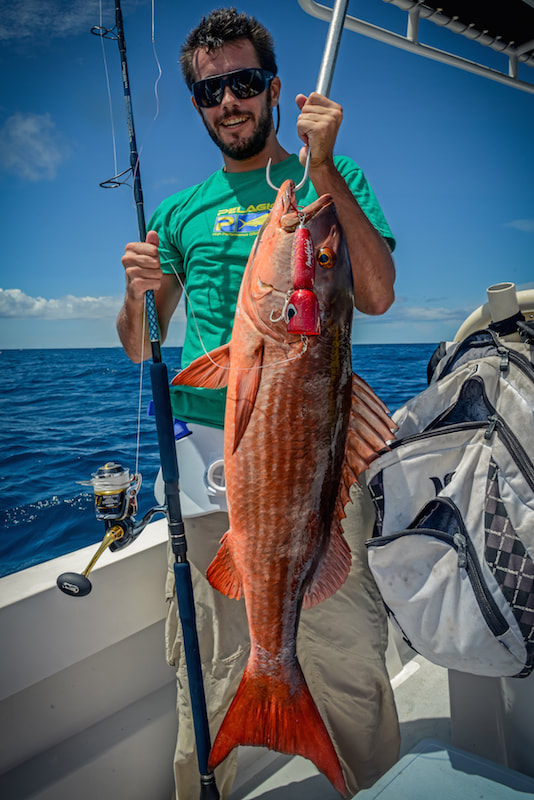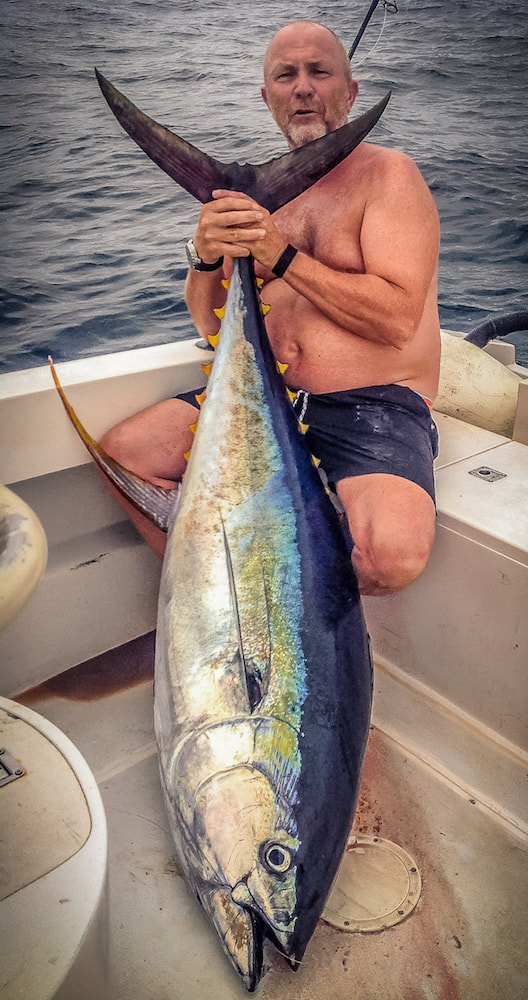Casting & Jigging:
|
Popping and jigging is what our clients come here for. We are lucky to operate in the most preserved fishery of Panama, where fish still react well to artificials and have not suffered from over-fishing or the constant use of live-bait that is common practice elsewhere. Our fishing lodge specifically addresses to active fishermen who love to cast and drop artificials. Animating artificials is definitely the most rewarding way to catch a fish but it is also tiring and demanding, so one should come prepared and willing to cast and jig all day long. Those are not necessarily some very technical techniques, so if you have not done it before or don't feel very confident, don't worry. Our captains can rapidly teach you how to do it well and you will catch in no time. Most of the casting is done using poppers and sinking or topwater stickbaits. Alternatively, you can use spoons, flappers, swimbait and crankbait and anything else they wish to try. Spinning gear is the most appropriate tackle for this game. Most fishermen have a love affair with top-water lures because of the visual, hair-raising attacks and strikes it triggers. We are blessed that most species found in Panama readily hit a surface lure. The casting is done on top of underwater structure, towards rocky outcrops and islands, along the beaches or into feeding frenzies. The quarries and most common catches include rooster fish, cubera snapper, yellowfin tuna, jack crevalle, big eye jack, mullet snapper, bluefin trevally, various shark species, rainbow runner, sierra mackerel, dolphin fish, yellow snapper, corvina, wahoo and more. |
|
The jigging we do here is mostly speed-jigging, a very effective method for all bottom and mid-water dwellers. However, the new trend of slow-jigging has also made it to here and more and more guests are using slow jigs with really good results. Our jigging spots are relatively shallow (120 to 450 feet), allowing the use of rather light jigs and gear. This means that the jigging we do, while still being physical, is pleasant and not exhausting. Adding this to the possibility of using slow jigs means that anybody can enjoy the jigging technique, even newbies. The strike of a mysterious fish on a jig is always something special, and the jigging allows for even greater variety with catches like amberjacks, various grouper species, numerous snapper species, skipjack and yellowfin tuna, jack crevalle, african pompano, corvina, roosterfish, rainbow runner, bonito and more.
|
Throughout the day, we constantly switch between light popping, speed or slow jigging in relatively shallow depths, and heavy popping. That keeps things interesting, of course, but above all, it means welcome changes of rythm and some rest from the heaviest tackle. Those of you who have been fishing destinations where you throw 150gr. poppers all day long will agree that it is not so fun after the first 2 hours.
Trolling & live-baiting:
We do very little trolling and live-baiting. These latter techniques can be done on request but if it is the kind of fishing you prefer, there are better places than ours. Please be aware that we do not carry specific trolling equipment. Should you wish to troll a little to rest your arms, it can be done using the jigging rods. We also try to avoid using live-bait, mainly because although it is an effective method for sure, we do experience a very bad survival rate (even using non-offset circle hooks). We have the privilege to be the only ones fishing this area so we try to do that with respect and sportsmanship. Live-baiting can still be done on request or to try and save the day, but again, if you want to concentrate on this, you are in the wrong place.
To summarize, let's say that backing down on marlin using big sport-fishers and reels weighting over a 100 ounces is not our thing. To us, nothing beats a surface strike from a roosterfish or the fight with a big amberjack on light tackle.
We do very little trolling and live-baiting. These latter techniques can be done on request but if it is the kind of fishing you prefer, there are better places than ours. Please be aware that we do not carry specific trolling equipment. Should you wish to troll a little to rest your arms, it can be done using the jigging rods. We also try to avoid using live-bait, mainly because although it is an effective method for sure, we do experience a very bad survival rate (even using non-offset circle hooks). We have the privilege to be the only ones fishing this area so we try to do that with respect and sportsmanship. Live-baiting can still be done on request or to try and save the day, but again, if you want to concentrate on this, you are in the wrong place.
To summarize, let's say that backing down on marlin using big sport-fishers and reels weighting over a 100 ounces is not our thing. To us, nothing beats a surface strike from a roosterfish or the fight with a big amberjack on light tackle.
Chasing tuna:
|
Although small yellowfin tuna up to 50 pounds are caught all year round on jig and topwater lures, what we call our tuna season starts in May and ends in October. During this time of the year, tunas are pleintiful and come very close to shore. The average size of the fish we encounter jumps to 80 pounds and even really big fish up to 300 pounds can be found as close as 8 miles away.
Tunas can be caught on topwater lure. They are at times very effective and it is a really fun way to fish them. However, the most consistantly effective method to fish for them is freelining a dead sardine on a circle hook thrown with some chum. That is an "easy on the arms" technique (well, until a fish is on the line) that anybody can enjoy regardless of it's experience and shape. The tunas we have here tend to be smaller than in the Gulf of Chiriqui. Although we have some 200+, most fish will be 70 to 150 pounds. If you consider that we fish them with the lightest spinning gear possible, you will probably be happy that the fish is of manageable size. Landing a 100 pounder on spinning gear takes a lot of time and effort, and it is more fun and more challenging than using heavy gear and big overhead reels. The really good thing about tuna fishing on the aptly named Tuna Coast is that you don't have to run 40 miles and back to get to the fishing grounds. In fact, most of the time we will find the tunas within 15 milles. Another reason to come here for some tuna fishing is that you won't be surrounded by 15 other sport-fishing boats and a yelling crowd waiting their turn to cast to the fish. Those who have been fishing for tuna in the Chiriqui probably know what I mean... |
Although we do keep a few selected fish for dinner and for our captains to bring home, catch & release is what we do !




